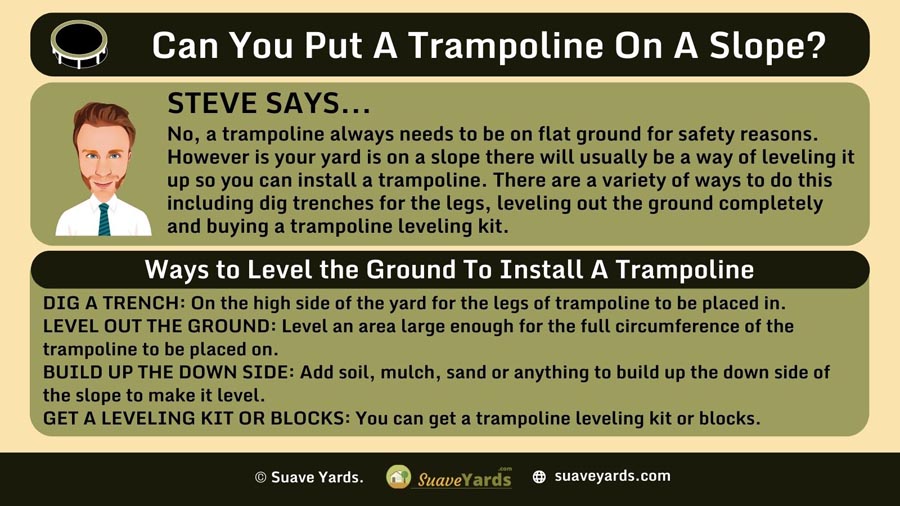
Not all yards are created equally, some are flat and some are… less than flat!
If you fall into that second category, it might leave you scratching your head when installing a trampoline.
Can you put a trampoline on a slope or does it need to be on flat ground?
That is what we are going to look at today.
So let’s get started…
Can You Put A Trampoline On A Slope?
No, a trampoline always needs to be on flat ground for safety reasons. However, if your yard is on a slope there will usually be a way of leveling it up so you can install a trampoline. There are a variety of methods you can use including digging trenches for the legs, leveling out the ground completely and buying a trampoline leveling kit.
Trampolines and Sloped Yards: The Bottom Line
The long and short of it is that a trampoline should never be installed on a slope as it is dangerous.
A trampoline needs to be on flat ground.
The main concerns around putting a trampoline on a slope are:
- The trampoline will be unsteady and prone to sliding down the slope it is positioned on.
- Anyone jumping on the trampoline will naturally gravitate to the lower edge of the trampoline when bouncing on it. This will mean there is an increased chance of an unbalanced landing and an injury as the ground is sloping away.
- The uneven distribution of weight and increased usage on this part of the trampoline will mean the mat and springs wear out more quickly, and the trampoline’s lifespan will be reduced.
To summarise, a trampoline on flat ground is safer, will last longer and will be more fun.
Therefore if you have a sloping yard, and are considering getting a trampoline you have two options:
- OPTION 1: Don’t buy it.
- OPTION 2: Buy it and do some work to make sure that the area where you install it is flat.
So let’s look a bit more closely at Option Two.
Leveling the Ground to Install A Trampoline

Determine the Slope
Obviously the first thing you need to work out is exactly how much of a slope you have in your yard.
You can do this in one of two ways:
METHOD ONE
Get a wooden plank, a carpenter’s level and a tape measure and then follow the steps below:
- Place the plank on the spot in your yard where you want to install the trampoline.
- Place the level on top of it.
- Lift the plank slowly until the bubble is level in the spirit.
- Measure the distance from the plank to the trampoline mat. Make a note of this distance.
- Divide this distance by the trampoline diameter, making sure you are using the same unit of measurement.
If the value is 7 or under, then you have a minor slope and you should be able to level the ground reasonably easily.
If the value is over 7 then you have a major slope and you might need to consult a professional landscaping company to ensure the ground is level.
Either that or you might not want to buy a trampoline at all.
METHOD TWO
For the second method decide where you would like to place the trampoline in your yard then:
- Place a stake at the high end of the yard where one side of the trampoline will be.
- Place a stake at the low end of the yard where the opposite of your trampoline will be. Obviously you will need to know the trampoline’s diameter to do this, so if it is 13ft there should be 13ft between the two stakes.
- Tie a piece of string from one stake to the other. You will want it attached to the bottom of the stake on the high end and nearer the middle of the stake on the low end.
- Using a carpenter’s level adjust the string on the stake on the low end, until it is level.
- Measure from the point where the low-end stake meets the ground to the string.
Similarly to the above if this measurement is 7 inches or under, you have a minor slope and should be able to install the trampoline.
Anything over 7 inches, might be too problematic or you might need to seek the help of an external company.
Choose Your Levelling Option
When you have worked out the slope of your yard you then need to work out exactly how you are going to level up your trampoline.
There are a few options and we will give a brief overview of each:
OPTION ONE: Dig A Trench
One of the most popular ways to level a trampoline is to dig a trench on the high side of the yard for the legs of the trampoline to be placed in.
Obviously the depth of the trench should be equal to the slope measured and you will want to use your trusty level to make sure the trench you have dug is level.
You might want to dig the trenches an inch or so lower than needed and add some back soil to make sure the legs are well-supported.
OPTION TWO: Level Out the Ground

An extension of option one is to level out an area large enough for the full circumference of the trampoline rather than just digging trenches for the legs.
Mark out the diameter of where you want your trampoline, find the lowest point using one of the methods outlined above and then dig everything to this level.
This is more work than option one, but will most likely provide a stabler base and is a good permanent solution.
OPTION THREE: Add Soil on the Down Side
This is the opposite of options one and two.
Essentially it is building up the side of your yard that is sloping downhill with soil, mulch, sand or anything that will make it level.
Depending upon the size and nature of the garden this can be more tricky than options one and two, and probably more costly.
OPTION FOUR: Get A Leveling Kit
A trampoline leveling kit simply extended the legs of a trampoline at a height according to your needs.
The benefit of this approach is you don’t have to worry about leveling the ground at all.
OPTION FIVE: Buy Some Leveling Blocks
You can also buy leveling blocks.
These stackable blocks are not specifically for trampolines but can be used to raise the legs of a trampoline on the downward slope and provide a stable base.
This is another low-cost, easy way to try and level your trampoline, however it will probably not provide as stable a base as a properly leveled ground.
To get an idea of what we mean, read our post on how to protect swing sets from weed wackers, and look at the suggestion of LevelDry blocks.
OPTION SIX: Cut the Trampoline’s Legs
This is probably the option I would recommend least on this list, but very much as a last resort, you can cut down the legs of the trampoline to level it up.
Obviously the dangers of this are that you cut the legs too short and that you don’t cut them properly, which can make the trampoline dangerous.
Also once this is done you cannot use the trampoline in any other location and any resale value of it has gone.
Note that trampolines don’t have adjustable legs either.
OPTION SEVEN: Bury the Trampoline
The final and most complicated way of leveling a trampoline on a slope is to sink it into the ground.
This is essentially digging a big hole in your yard to the required depths, and burying it in there so the mat is ground level.
You will probably need to get professionals in to do this, and it will be costly, but it will be effective.
Final Thoughts

It is essential that a trampoline is installed on flat ground for safety reasons.
However this doesn’t mean just because your yard is on a slope that it can’t be home to a trampoline for your kids to enjoy.
It just means a little bit of work is needed.
Unless your yard is on a drastic slope it can usually be leveled up using one of a variety of methods.
The most important thing is to work out the extent of the slope of your yard and then work from there to ensure the trampoline is flat using one of the options outlined above.
Good luck!
